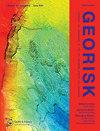Time capsule for landslide risk assessment
IF 4.8
3区 工程技术
Q1 ENGINEERING, GEOLOGICAL
Georisk-Assessment and Management of Risk for Engineered Systems and Geohazards
Pub Date : 2023-01-12
DOI:10.1080/17499518.2023.2164899
引用次数: 5
Abstract
ABSTRACT Landslides, one of the most common mountain hazards, can result in enormous casualties and huge economic losses in mountainous regions. In order to address the landslide hazards effectively, the geological society is required not only to develop in-depth understanding of landslide mechanism but also to quantify its associated risk. In this article, landslide risk assessment is categorised into two types, hard and soft risk assessments, and reviewed separately. The hard approach focuses on the mechanics and numerical simulations of individual landslides, subsequent consequences, and their uncertainty quantifications and probabilistic analyses while the soft approach explores the quantification of disaster risk components such as hazard and vulnerability at different scales of concern. It is hoped that this article can serve as a time capsule to link the preceding and following of landslide risk assessments and shed some light on future studies.滑坡风险评估的时间胶囊
本文章由计算机程序翻译,如有差异,请以英文原文为准。
求助全文
约1分钟内获得全文
求助全文
来源期刊
CiteScore
8.70
自引率
10.40%
发文量
31
期刊介绍:
Georisk covers many diversified but interlinked areas of active research and practice, such as geohazards (earthquakes, landslides, avalanches, rockfalls, tsunamis, etc.), safety of engineered systems (dams, buildings, offshore structures, lifelines, etc.), environmental risk, seismic risk, reliability-based design and code calibration, geostatistics, decision analyses, structural reliability, maintenance and life cycle performance, risk and vulnerability, hazard mapping, loss assessment (economic, social, environmental, etc.), GIS databases, remote sensing, and many other related disciplines. The underlying theme is that uncertainties associated with geomaterials (soils, rocks), geologic processes, and possible subsequent treatments, are usually large and complex and these uncertainties play an indispensable role in the risk assessment and management of engineered and natural systems. Significant theoretical and practical challenges remain on quantifying these uncertainties and developing defensible risk management methodologies that are acceptable to decision makers and stakeholders. Many opportunities to leverage on the rapid advancement in Bayesian analysis, machine learning, artificial intelligence, and other data-driven methods also exist, which can greatly enhance our decision-making abilities. The basic goal of this international peer-reviewed journal is to provide a multi-disciplinary scientific forum for cross fertilization of ideas between interested parties working on various aspects of georisk to advance the state-of-the-art and the state-of-the-practice.

 求助内容:
求助内容: 应助结果提醒方式:
应助结果提醒方式:


